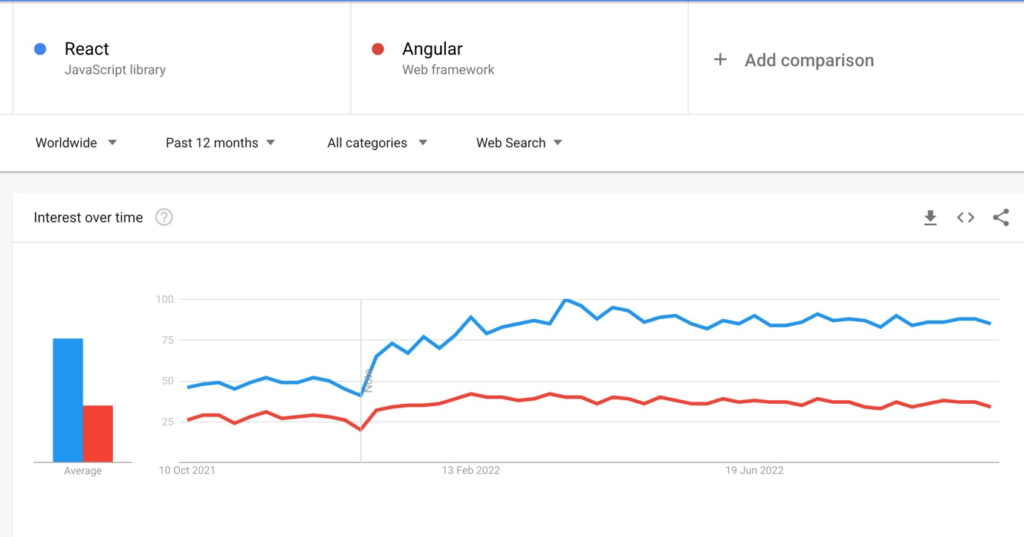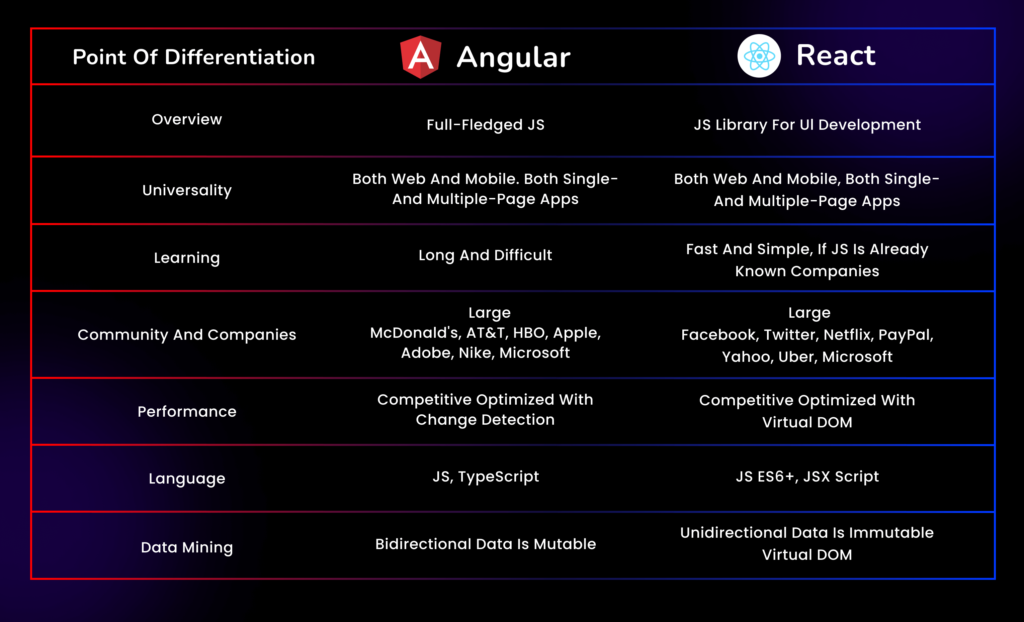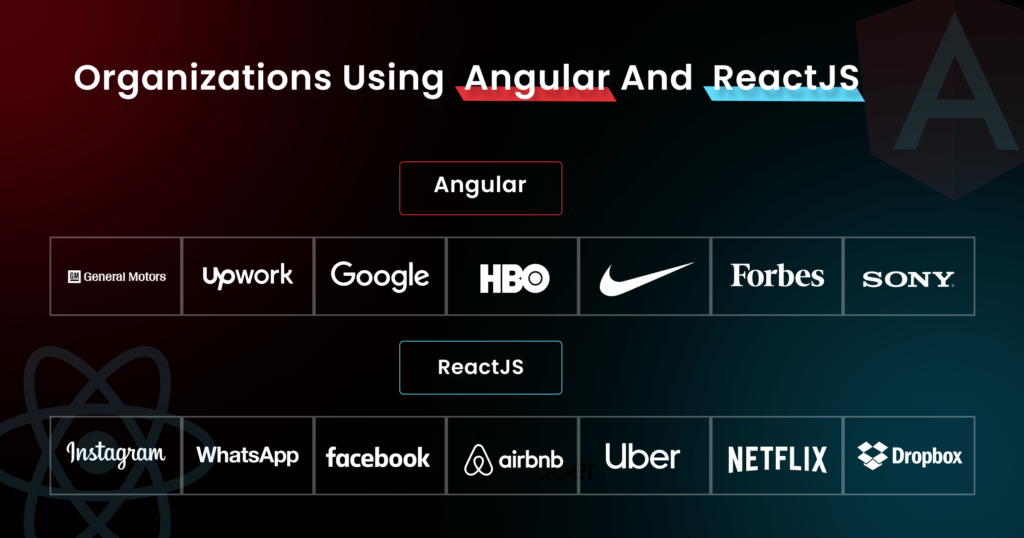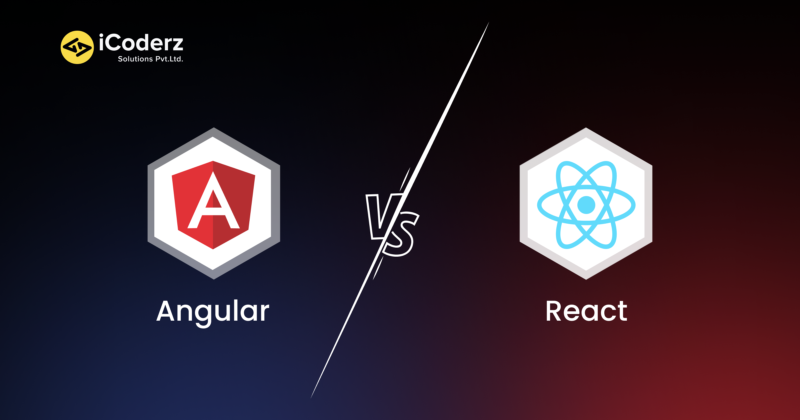Table of Contents
As a developer, your work is not finished, not by any means. An alarming amount of frameworks and tools are becoming available on the market. As powerful and well-developed open-sourced libraries and frameworks, respectively, React and Angular have emerged. There is a war going on for website and mobile app frameworks! The finest options for creating a reliable, scalable, and high-performing app are Angular and React. You may assess how well angular js vs react js might fit into your forthcoming web and mobile applications by comparing their scalability, integration potential, and framework-level efficiency.
What is React?
User interfaces are made using the React JavaScript library. Facebook invented it, and businesses like Netflix, Airbnb, and Instagram all make use of it. ReactJS is a declarative, effective, and adaptable JavaScript user interface library. To make your code simple to read and maintain, it enables you to design reusable components.
Creating components that are extremely reusable and assisting in a modular, cohesive development process. The logical portion of an app can also be reused by the developers by just switching the view. Self-contained components make maintenance and upgrade simple.
What is Angular?
A framework for creating client-side web apps is called Angular. It is among the most widely used frameworks right now. Angular, which was introduced in 2016, is an entirely new version of AngularJS. The Angular Team at Google and a network of people and businesses are the driving forces behind Angular, an open-source web application framework built on TypeScript. A platform for creating desktop and mobile web applications is called Angular.
You can use AngularJS to expand HTML’s syntax and utilize it as your template language to represent your application’s components quickly and unambiguously. The fundamental units of an Angular application are components. An Angular application is made up of a tree of components, the root component being the one at the top.
Also Check: Best Backend Frameworks for 2024
Statistics Of both Technologies Angular vs React
Google Trends comparison between angular vs react in the below image makes it crystal obvious that Reacts is growing in popularity in 2022–2023. Facebook published a potent library in 2013. React, on the other hand, is already well-known and well-established in the field, whereas Angular is still somewhat unproven. Major corporations, however, choose both react and angular when it comes to recognition. Therefore, we can claim that in 2022-2023, you can choose either React or Angular for web app development.

React vs Angular as Frontend Framework
There are a few key differences between Angular and React as frontend frameworks. Angular is a complete framework, meaning it provides more built-in features and tools out of the box than React does. However, this also means that Angular is more opinionated than React, meaning that it requires you to follow its conventions more closely in order for your code to work properly.
React, on the other hand, is a much lighter-weight framework. It doesn’t provide as many built-in features as Angular does, but it also gives you more flexibility in how you structure your code. This can be both a good and a bad thing, depending on your needs and preferences.
Finally, one key difference between these two frameworks is their licensing. Angular is licensed under the MIT license, while React is licensed under the Facebook BSD+Patents license. This means that if you want to use React in your project, you will need to make sure that all of your code conforms to Facebook’s standards.
Which is Better Angular or React?

There are a few significant differences between Angular and React. First, React is a library, whereas Angular is a framework. This indicates that React gives greater flexibility, but Angular offers more structure for an application.
Second, React employs JavaScript, while Angular uses TypeScript. For developers who are already proficient in one of these languages, this may be important.
Third, Angular employs two-way data binding, whereas React only employs one. This implies that the UI will update automatically to reflect changes made to data in Angular. With React, any data changes require the developer to manually update the user interface (UI).
Fourth, React apps tend to be smaller and easier to use than Angular apps, which are often more extensive and more complicated. The reason for this is that Angular has more built-in features than React.

Fifth, React depends on the Virtual DOM, whereas Angular depends on MVC (Model View Controller).
Sixth, JavaScript libraries cannot be added to the source code of AngularJS. However, they may be added to the source code of React.
Seventh, AngularJS enables you to test and debug an entire project with a single tool. But for various testing tasks, React requires a set of tools.
Eight, An UI development framework called React was created. As a result, React-based projects need the use of extra libraries. Angular, on the other hand, is a feature-rich software development framework. Usually, it doesn’t require any more libraries.
Ninth, The use of virtual DOM enhances React’s performance. The performance of Angular is subpar for dynamic and sophisticated web projects. Bidirectional data binding has a significant negative impact on how quickly Angular apps perform.
Tenth, React is better suited for web applications, but Angular is great for both mobile and web development.
Eleventh, Unlike React, which lacks an in-built package for some features like forms, routers, state management, and material components, Angular provides built-in support for a variety of features. To utilize these features in React, we must include the appropriate third-party libraries.
Finally, Angular’s development cycle is shorter than React’s. This is since changes made to an Angular app are promptly reflected in the user interface (UI) without requiring a code recompile. On the other hand, modifications made to a React app need to be recompiled for the UI to reflect the changes.
Popularity Growth: Angular vs React JS
Two of the most widely used JavaScript frameworks nowadays are Angular and React. Both are supported by a sizable developer community, are open-source, and are free to use. But which one ought you choose for your upcoming endeavor?
We’ve put together a thorough comparison guide for angular vs react js to aid with your decision-making. In this essay, we’ll side-by-side compare Angular and React while examining their similarities, differences, and features. By the conclusion, you’ll understand which Front-End Framework is best suits your requirements.
Let’s get going!
Use Cases: Angular and Reactjs
These prominent front-end players are among the enormous number of businesses that use React and Angular for their front-end web application development needs.

Through this post, we hope to shed some light on one of the most basic questions that many developers are probably asking themselves: Angular or React. We will explore and compare these two powerful frameworks to help you make better decisions for your applications.
When I first started, I didn’t know much about Angular. I was hesitant to choose it. However, as I learned more over the years, my opinion changed. I realized that many large and mid-sized projects included complicated third-party integrations requiring additional plugins and integrations. When you introduce more elements into the mix, things become more complex and take longer to set up to work properly with your project.
Angular is a web development platform that, based on typescript, has been successful in increasing its popularity among developers. Reactjs is a javascript library specifically used for building user interfaces by reusing UI components, and it has become popular due to the rise of single-page applications.
He’s mentioned two popular examples of using Angular and React. These are:
Use Case 1:
You are starting a complicated UI project from scratch because Reactjs is easier to use. Reactjs is the ideal choice for a reduced learning curve, although Angular is an option if you have the time for a longer learning curve.
Use Case 2:
Angular is the full package with crucial functionalities included as a built-in component. It is impossible to compare its functions with those of only Reactjs and a react library. Experts in Typescript should continue using the framework and not simply skip using Angular.
Why you Should Choose AngularJS:
There are numerous benefits to using Angular while creating applications. From the user interface to the data layer, Angular is a complete framework that comes with everything you’ll need to build an Mobile application. This implies that everything you need is already included in Angular, so you aren’t required to piece together other libraries to get your project up and running.
The robust TypeScript support offered by Angular Development is another factor in the decision. A superset of JavaScript called TypeScript adds static typing and other features that simplify managing complex projects. By combining TypeScript with Angular, you can develop more maintainable code and catch mistakes earlier.
Additionally, Angular has a thriving ecosystem and community. You may learn and utilize Angular with the aid of a variety of tools, such as official documentation, online courses, and third-party libraries. And because Angular is used by well-known companies like Google, Microsoft, and IBM, you can be sure that it will be improved upon and supported for a very long time to come.

Why you Should Choose ReactJS:
Reactjs is superior to other front-end frameworks for several reasons. Reactjs is a javascript library. Thus one reason is that it is simple to integrate with projects and codebases that already exist. Reactjs’ component-based architecture makes code reuse easy and promotes modularity, which is another factor. Reactjs is declarative, making its code simpler to read and comprehend than that written in other frameworks.
You can simply create sophisticated user interfaces with React. Because a poorly designed user interface is typically less user-friendly, and the users will not enjoy an improperly designed UI, user interface quality is vital. Your users will adore using your web app if it has a stylish, high-quality user interface. Therefore, top-notch user interfaces are crucial for business success. You can indeed create cool interfaces to use other technologies, but React makes it simple to do so by using declarative components.
Also Read: Top 5 Front-end Web Development Tools
React’s extensive community support is one of the main reasons you should choose it for front-end development. Since it’s an open-source library, a sizable community of React developers is working to improve it while also assisting users in many ways to learn the technology. While some people produce informative tutorials, in-depth essays, and blog entries, others publish free React tutorial videos on YouTube. This library has 1,198 contributors and 106,128 ratings on GitHub as of the time this article was written.
It includes a suite of practical development tools. Only when done properly can learning about emerging technologies and putting them to use in real-world applications be pleasant and helpful. Facebook is aware of this, which is why they added some much-needed React and Chrome development tools to their React JS framework. In essence, these React tools aid developers in finding child and parent components, observing component hierarchies, and inspecting the current state and props of components.

How Much Does it Cost to Hire React or Angular Developers
Let’s say you’re curious about the cost of hiring angular developers or Hire React Developers. In that situation, the cost of developing an angular app or react app relies on the location and experience of the developer. In contrast to India, the USA will charge more to Develop Mobile Apps or websites.
It’s crucial to take into account various average salaries for the services offered when Hiring AngularJS Developers or react developers for the business or corporation. These developers usually charge anywhere from $10 to $150 per hour. The costs vary according to the level of expertise, location, skill set, and type of angular development services that the experts are contracted for.
Frequently Asked Questions ( FAQ’s )
What Distinguishes React from Angular?
Ans: Angular is a full-featured framework, whereas React is a Javascript library. While Angular employs actual DOM and two-way binding, Reactjs uses virtual DOM and one-way data binding. Additionally, there are differences in speed because React is quicker than Angular and in bundle size. After all, React is smaller.
Is Angular superior to React?
Ans: No! Because of its virtual DOM implementation and rendering optimizations, react surpasses Angular. Switching between React versions is quick and easy, unlike Angular. It’s not necessary to apply updates one at a time. When using React, developers have access to a huge selection of pre-built solutions.
Can I learn Angular if I have React knowledge?
Ans: Yes, learning Angular is advantageous for you if you are already familiar with React. React allows you to accomplish practically everything that Angular allows you to do, or we might say that React allows you to accomplish much more. However, if you are a developer and can learn React, you can also learn Angular, so work to become an expert.
Why is React more Responsive than Angular?
Ans: The virtual DOM used by Reactjs apps allows developers to make changes without writing the whole HTML. It guarantees faster performance by rendering changes more quickly.
React is a Library, Not a Framework.
Ans: Whether react to a framework, or a library is a constant point of debate among users. But in this section, we’ll expose the fact that Reacts was constructed using JSX and is a Javascript library.
How do you Decide Whether to Utilize React or Angular?
Ans: Angular is preferable to react if your application is enterprise-grade and you need to integrate complicated functions like progressive, single-page, and native web apps. The use of React, on the other hand, may be applied to any application, including single-page.
Which is More User-friendly, Angular or React?
Ans: React is simpler than Angular, in response. React offers several work options for developers, whether they are new to the field or more experienced. Studying native React allows you to rapidly and simply create mobile apps, which is another advantage of learning React.
Why do we Pick Angular over React, you ask?
Ans: Angular’s two-way data binding, which is superior to React’s one-way data binding, guarantees that data is always in sync at all levels. Although angular allows you easier code creation, react has a lower learning curve and offers a cross-platform framework solution.
Is it possible to Combine AngularJS and ReactJS?
Ans: The supported version of responding is 15.3.2; server-side rendering is not supported. To use the GoodData React components in your angular 2+ environment, you must wrap each component in an Angular component. After, you need to use ReactDom to render the React component.
Angular is a UI framework, yes.
Ans: Because it was influenced by Google’s Material Design, Angular Material was created as an extensive library of reusable UI components. For all of your UI demands, it has a relevant and comprehensive solution.
Conclusion: Angular or React
There are significant differences that come down to cultural and technological attributes, even though both are crammed with community support and common single-page web app development capabilities.
However, Angular and React provide the finest of both worlds when it comes to developing and deploying web apps of the highest calibre with a focus on a flawless user experience.
There is no apparent winner when deciding between Angular and React. Both frameworks have advantages and disadvantages that make them appropriate for various project types. Angular might be a better option if you’re seeking a framework that has more outspoken opinions and offers more pre-built functionality. React might be a better choice, though, if you like a framework that is more lightweight and allows you more freedom. In the end, the best approach to choose is to assess your unique needs and determine which Front-End Framework best meets them. Both are incredibly strong, advancing web programming by enhancing, facilitating, and accelerating development. If you run into any problems, seek help from a professional.




